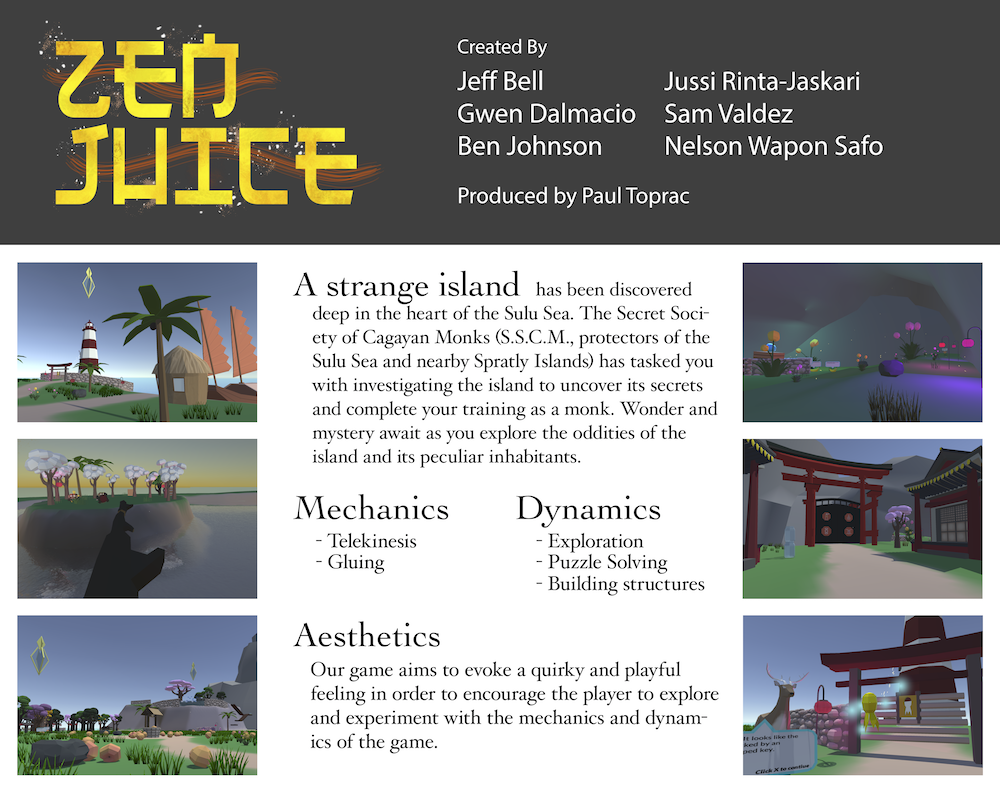Zen Juice Beta

Beta beta beta! I was kept extremely busy this week preparing for and showing
off the beta version of Zen Juice. This was our last major playtest for the
game and there was a lot that we needed to do to get it ready.
The Game
The main development focus was to get the game ready for a release. This meant that on Wednesday, we wanted to have a game that could be played from start to end with nothing blocking the user from finishing. A major component of this was optimizing our game for VR.
While the aim was always to use virtual reality as our challenge platform, we hadn’t previously spent much time refining the VR experience for our game. This week we put in many hours fine-tuning the code and environment for Oculus users. It felt very full-circle. Thanks to nearly a day of continuous development before the deadline, it was much like our Game Jam at the beginning of the semester.
The Poster Session
The first major event of the week was a poster session. As a part of my requirements for the Bridging Disciplines Program, I was required to present my creative project at a poster session. Zen Juice is serving as my creative project for the certificate program, so I presented it on Tuesday.

Overall the poster session went very well. We were the only group presenting a live demo of a 3D video game at the poster session. Our game caught the attention of quite a few people. Even if they weren’t eager to try playing the game, everyone enjoyed seeing someone play it. It was nice to take a step back and see what we’ve created in a low-stress environment.
The most important thing we learned at the poster session was that our game has a non-trivial skill requirement. People who aren’t familiar with an XBox controller or don’t usually play video games had a very hard time even completing the tutorial of Zen Juice.
I left the poster session feeling good about all of the work we’d done. There was a slight emptiness, however, from the realization that many people would never really be able to play our game. I suppose that’s why we have a target audience!
The Playtest
The challenge of introducing players to our game continued through our playtest on Wednesday. Some players, who were more experienced gamers, caught on very quickly. Others struggled to use the basic mechanics of the game. For the beta release, we had revamped the tutorial to include some animatics which show the player what to do rather than tell them. We found that players were able to breeze through the tutorial, but forgot what they’d learned once the time came to use it.
A long-term fix to this, and the general onboarding problem, would be to introduce the controls and the mechanics of the game more slowly. Perhaps we could add some intermediate puzzles in-between the control-based tutorial and the open-ended puzzles. Given that we only have a couple of weeks to clean up the game before publishing, we are opting for a simpler solution by adding some reminders of controls and mechanics in the areas that they are required. For example, if a player needs to use the gluing mechanic to build a bridge and they haven’t completed the bridge yet, a screen will pop up to remind them how to use gluing.
Those who were able to understand the game averaged around 20 minutes for a play, which is exactly what the scope of our game was supposed to be. People who didn’t catch on as quickly took upwards of 40 minutes to an hour. Even with in-game hints, some players struggled to perform the actions they needed to in order to beat the puzzles. From what the trend looked like, if someone was familiar with other VR games or an XBox controller, they were very successful. Other people tended to struggle for a long time, and some did not finish.
What’s Next?
Publishing! Now that the beta version of the game has been released, we need to clean up the bugs we observed in beta and publish the game. We are looking at putting it on itch.io and possibly on the Oculus store as well.
We only have two other major events coming up for the class. The first is the postmortem presentation for our game. We will travel to a nearby game company and present our game to their team. The second is the university game exhibition where we will have our game in an exhibition for the public to play. After these, that’s the end of the class! I’ll be sure to write an update once the game is published, but until then, happy hacking!